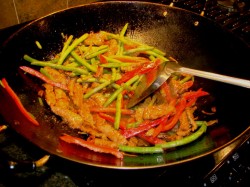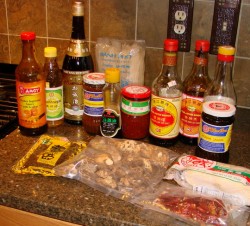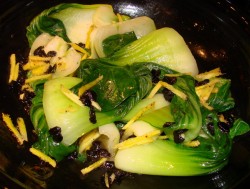Celebrate National Pig Day
How would I like everyone to celebrate National Pig Day?
Well, first of all, I would like everyone to recognize where the vast majority of the pork in thi country comes from: industrial farms which are pretty much nothing less than disgraceful threats to the ecological and medical health of our communities. Not to mention that they are also pits of hellishly unethical treatment for animals. (And no, I am not a PETA member. While I dislike industrial farming with an intense passion, I also dislike and mistrust the tactics, rhetoric and clandestine dealings of PETA. Their leader, Ingrid Newkirk has taken positions which I find not only to be ethically questionable, but also personally repugnant. But, that is fodder for another post.)
If you don’t believe me, take a gander at this article exposing Smithfield’s pork operations from Rolling Stone. Or this paper entitled, “Environmental Injustice and the Mississippi Hog Industry.” Or any of the articles linked to the Factory Farming website. And this article by the Sierra Club reporting on the dangerous working conditions of pork slaughterhouses in North Carolina, and the unfair treatment of the primarily Latino workforce. (While you are there take a glance at the tiny photograph of the filthy pigs crammed into a confinement pen together at an industrial farm and compare it to the photograph below.)
Then, do me a favor and take a good look at this picture.
They are cute little guys, aren’t they? This photograph was -not- taken at an industrial farm: this litter of clean little piglets is being raised on a more traditional, diversified farm where the animals are not treated as commodities. Farms such as this also do not wreak environmental damage from toxic runoff causing human illness, fish die-offs and the lowering of property values.
Granted, those cute wee piggies are going to grow up and be slaughtered, hopefully in an ethical, quick and as painless a fashion as possible. Death is inevitable when you are raising meat, after all. But, I want everyone who is going to eat meat, to at least look it in the eye and recognize what they are doing as they do it. That is why I wrote “Meat Comes From Animals, Deal With It Or Eat Vegetables;” I wanted carnivores to own up to what they eat.
And I hope that if you are disturbed by what you learn about industrial meat production, that you take steps to lower your own consumption of these products. Look around your local area, and see if there is a small farmer who raises pigs in a more ethical, healthier fashion, and patronize them. (Try looking here at Local Harvest: a comprehensive, ever-growing online listing of local food producers from all over the US.) If you cannot afford much in the way of local meats (they tend to be more expensive, but they not only are healthier for you, the animals, the farmer, and the planet, they -taste- better than industrial meat), then eat less pork, and maybe more tofu. Or beans. Use meat as a seasoning, not as the central item of your menu, just as folks have done all through time.
There are national producers of ethically raised pork. Niman Ranch is one, though their products are expensive. Expensive they may be, but they are tasty–and they also produce beef and lamb.
When you go out to eat, try and patronize restaurants that use locally produced sustainable foods. Here in Athens, we have Casa Nueva and The Village Bakery, among other local eateries, that concentrate on local, organic ingredients. Or, if they are near you, patronize the chain Chipotle, which uses as many organically raised, sustainable ingredients possible to make their tasty burritos. They start out with top-quality fresh raw ingredients (they buy their pork from Niman Ranch),and cook on site to make fast food that doesn’t taste fast. It tastes good.
Or, become a vegetarian, if the meat industry really torques you off. If I didn’t live near great farms that produce wonderful meat, that is what I would do. As it is, I eat less and less meat every year. I enjoy it when I eat it, but I still like vegetables and tofu just as much, or sometimes, more, than most meat. And,Then frankly, if I ate primarily Indian, Chinese, Thai and Mexican foods, I could probably be quite happy as a vegetarian. (That is, until I smelled bacon cooking or saw someone eating raw tuna. Then, I would probably backslide horribly.)
What is the upshot of all of this?
Well, as much as I love pork, and I do–as a look through the recipes on this blog will show–I love pigs, too. And I love clean water, clean air and healthy people. And frankly, the pork industry does a crappy job at taking care of the pigs, water, air and people I love. Besides all of that, their pork is dry, tasteless, and is usually pumped full of water, salt and other seasonings. Ick.
Which is why I don’t eat “The Other White Meat,” from the grocery store, nor will I.
If I cannot get it from a local farmer whose practices I know and trust, and who produces tasty and healthful pork, I won’t eat it.
Now that I am off of my soapbox, here is a recipe that uses both pork and tofu that has become one of my favorite dishes of all time: Spicy Pork with Pressed Tofu
Beef With String Beans and Sweet Pepper
This is my first official experiment in my quest to create accessible, simple recipes for those who are new to cooking Chinese foods, and it came about because I had a piece of beef top round thawed that needed to be cooked. I also had some string beans and a sweet red bell pepper sitting about in the crisper drawer, so I decided to cook them all together.
Most often, stir-fried beef is paired with oyster sauce and broccoli in Chinese-American restaurants. It can be a great combination; the slightly bitter edge of the broccoli pairs well with the strong flavor of the beef, while the oyster sauce tames them both and gives an oceanic fragrance to the entire dish. That is, if it is executed well. If it isn’t, the dish turns into a brown-sauced gloopy mess filled with oil and lackluster in flavor.
In this dish, I eschewed the oyster sauce, and instead, decided to use the minimal flavorings of Shao Hsing wine and dark soy sauce paired with a tiny bit of sugar, and a dash of rice vinegar then finished with a kiss of sesame oil. For the aromatics, I used a lot of ginger; I find that the assertive floral fragrance perfectly freshens the strong flavor of beef. I also used scallions and an optional fresh chile pepper, just to add a tiny spark of heat.
As for the beans, because I wanted them to be tender crisp, and I wanted them to take in a bit of the flavors of the sauce, I decided to blanch them before tossing them in the wok. This step is simple, fast, and helps soften the outer skin of the beans a bit so that they stir-fry faster and also absorb some of the flavors in the wok more readily. All one needs to do is to bring a pot of water that will hold all of the beans to the boil, dump the beans in, give them a stir, and let them cook for about two to three minutes, or until they just brighten in color. Then drain them, rinse in cold water and drain until you are ready to cook. That is it.
The prep for this stir-fry took me approximately twenty minutes; however, I acknowledge that I cut quickly. In order to cut the time, one could snap the ends and strings from the beans, cut the pepper and the meat the night before. If you decide to marinate the meat overnight, please do not add the soy sauce until twenty minutes before you plan on cooking, so as to avoid having the meat absorb too much salty flavor.
Beef With String Beans and Sweet Pepper
Ingredients:
3/4 pound top round, cut into 2″X1/2″X1/4″ slices
1 tablespoon Shao Hsing wine or dry sherry
1 tablespoon dark soy sauce
1/2 teaspoon raw or brown sugar
2 tablespoons cornstarch
3/4 pound string beans, tops and bottoms trimmed and stringed if necessary
2 1/2-3 tablespoons peanut or canola oil
2 tablespoons fresh peeled ginger, cut into thin matchstick slivers
1 green serrano chile pepper, cut thinly on the diagonal (optional)
5 scallions, white and light green parts only, trimmed and washed and sliced thinly on the diagonal
3 tablespoons Shao Hsing wine or dry sherry
1 tablespoon dark soy sauce
1/2 teaspoon rice vinegar
1 medium red or orange sweet bell pepper, cored and sliced into long, thin slices (about the size and shape of your beans)
1/4 teaspoon sesame oil
Method:
Mix together beef, and the first measures of wine and soy sauce with the sugar and cornstarch. Allow to marinate for twenty minutes.
Bring water to boil in a pot large enough to contain the string beans. When it boils, add the beans, stir and allow to boil for 2-3 minutes, or until the beans deepen and brighten in color and become somewhat tender. (Tender-crisp is the best way to describe them–the outside softens just a bit, but the interior is still “snappy.”) Drain, rinse with cold water and drain until you are ready to cook.
Heat wok until a thin thread of smoke dances up. Add peanut or canola oil and swirl to coat bottom of wok. Allow to heat for about thirty seconds. Add ginger, chile if you are using it and scallions. Stir and fry for about thirty seconds or so. Add meat, level it into a single layer on the bottom of the wok and allow to cook undisturbed for about a full minute–until you see and smell browning occurring. Once meat browns on the bottom, start stir frying vigorously.
Deglaze the bottom of the wok with the second amount of wine, then add the soy sauce, and stir until the meat darkens. Cook until almost all of the meat is brown,with no red showing. Add the beans, and stir fry for about a minute. Add the peppers and the vinegar and stir fry for about forty-five seconds. Add the sesame oil, stir once or twice more, take wok off the heat and serve with steamed rice.
Note: A similar dish can be made with pork or chicken by changing the flavorings. For pork, use only one tablespoon of ginger, and add 2 cloves of garlic, cut like the ginger. Add it after you add the meat by sprinkling it over top the meat while it is browning on the bottom. For chicken, use either ginger or garlic, whichever one you prefer. For both chicken or pork, use light soy sauce instead of dark and take out the vinegar. Black mushrooms can be used instead of the peppers in any of these recipes.
To cook this with tofu instead of meat, use either extra firm tofu that has been pressed to expel even more water, or pressed spiced tofu. Cut the tofu into thin, narrow slices to mimic the shape of the string beans, and stir fry it as you would meat, only not as long. Be gentle, particularly with the extra firm tofu so you don’t break it all up.
Cooking With the Staple Ingredients of the Chinese Pantry
After my rant on the inadequate editorial treatment of Asian recipes in Cook’s Illustrated, a number of people commented that there was a great need for Chinese recipes that used a minimum of unfamiliar ingredients, used raw materials primarily available at the average American grocery store and yet which taught the neophyte cook how to make authentic foods that were yet true to Chinese kitchen philosophy.
Since I view CI’s efforts in this regard with a jaundiced eye, and find their editorial staff’s knowledge on the subject of Chinese food to be limited at best, I decided to throw my hat into the ring and see if I could turn my critique into a constructive answer to this apparent need.
Spurred by the requests of readers, I posted about the basic ingredients I consider to be essential to the beginning cook’s Chinese pantry. Looking at that list of ingredients, I began to think of writing a series of simple recipes which used these basic ingredients along with vegetables, fruits, tofu, fish, meat and poultry that are available at American grocery stores, farmer’s markets and CSA’s to create Chinese dishes that are not only fresher in flavor and more healthful than what is available in most Chinese-American restaurants, but also which uphold the philosophical underpinnings of Chinese cooking techniques.
So, look for two new categories to arise in this blog: The Chinese Pantry, and Simple Chinese Recipes, where I will file these recipes (and some older ones that fall under these parameters) as I write them in the future. Also look for recipes that encompass the full range of Chinese cookery: not only will there be stir-fried dishes, but those which are braised, steamed, fried, and even roasted. And–as always, look for more in-depth analysis of and recipes for staple Chinese pantry items.
Oh, and remember–“simple” does not mean bland, boring or plain. It means what it says–simple. A few ingredients, well-seasoned with a minimum of aromatics, cut precisely and cooked perfectly creates a simple–and beautiful–dish.
Inspired by Kylie Kwong: Bok Choy With Oyster Sauce, Ginger and Fermented Black Beans
Now that I have posted a list of basic Chinese pantry items, I think the next step is to create a series of simple recipes using a minimum of ingredients which just about anyone can recreate. The goal is to simplify Chinese cooking for Americans who have limited access to Asian markets while still making recipes that have the essential flavosr that are expected from Chinese food. In other words, this is my constructive response to Cook’s Illustrated Magazine’s flawed approach to presenting simplified, but inauthentic, Chinese recipes.
My inspiration for this recipe is Kylie Kwong’s Bok Choy with Oyster Sauce from her book Simple Chinese Cooking, but is not exactly as she wrote it. Her version has an even shorter ingredient list than mine; hers was simply bok choy, oyster sauce, sesame oil and peanut oil. To my palate, such a dish would be woefully bland, so I decided to change it considerably, while retaining the basic cooking methods and ideal of keeping a short, basic ingredient list.
The resulting dish, while simple and pure in flavor, was quite delicious and went very well with the Chicken with Cashews.
This is not a stir-fried dish; instead, the bok choy is blanched in boiling water for about one minute. Basically, it is cooked only until the leaves wilt, then it is removed from the cooking water, drained and dressed with the oyster sauce and sesame oil. Kwong then had the cook heat the peanut oil and pour it sizzling over the bok choy, but I went a step farther. I figured if I had to heat up oil, I might as well put something in it, so I added a tablespoon of fermented black beans and a tablespoon and a half of finely shredded fresh ginger. After the flavor of the black beans and ginger infused the oil, then I drizzled the whole crackling, fragrant mixture over the vegetable, then stirred it well.
(If you want a more subtle dish, use less black beans–about a teaspoon instead of a tablespoon, and cut down a bit on the ginger, too, if you like.)
It made a very simple, easily cooked vegetable dish to accompany a stir-fried meat dish. The texture of bok choy cooked in this way is very interesting: it is velvety, with a subtle crunch, but only if you are careful not to overcook it. The sauce makes a thin coating over the bok choy and echoes the smooth mouthfeel of the vegetable without being thick or sticky. The still crisp slivers of ginger add contrasting texture as well as a bit of a fiery flavor, while the salty beans give the entire dish a good dash of “oomph.”
Look for more simple Chinese style recipes here in the future using basic pantry items.
Bok Choy With Oyster Sauce, Ginger and Fermented Black Beans
Ingredients:
3/4 pound baby, young or Shanghai bok choy*, washed
1 teaspoon salt
1 1/2 tablespoons oyster sauce
1/8 teaspoon sesame oil
1 tablespoon peanut or canola oil
1 tablespoon fermented black beans
1 1/2 tablespoons fresh ginger, peeled and cut into thin slivers
Method:
After you have rinsed the bok choy, cut off the bottom core, to separate the leaves. Rinse the leaves well again, and set aside to drain.
Bring a pot of water big enough to hold all of the bok choy to a boil; add the salt and stir to dissolve. Add the leaves, and stir to get all of them under the water. Cook for about one minute; just allow the leaves to wilt and the stems to brighten in color.
Drain well, and place in a warmed serving bowl.
Toss with oyster sauce and sesame oil until leaves are well coated.
Heat peanut or canola oil in a small frying pan or wok. Add fermented black beans and ginger, and stir for about a minute to two minutes. Pour oil, beans and ginger over the bok choy and stir. Serve immediately.
*Note: Use the smaller types of bok choy if possible. Shanghai bok choy has yellow green stems (as opposed to white stems) and emerald green leaves, instead of dark green leaves, and is sweeter in flavor than more typical large white and deep green bok choy.
This basic idea can be used for other Chinese greens such as choy sum or gai lan; adjust cooking times to account for the denser plant tissues of gai lan. (In other words, cook it longer because the stems are thicker and harder than bok choy stems.)
From Simple Chinese Cooking: Chicken with Cashews
Chicken with cashews is a perennial favorite on the menu of Chinese restaurants all over the world.
Being that I love both chicken and cashews, by all rights I should love it.
However, far too often in my experience, it is a disappointing dish. Overcooked, bland chicken and soggy cashews drowning in puddles of oil and sticky but otherwise nondescript brown sauce is not really something that has ever tempted my palate. I have ordered it more than once, only to be sadly underwhelmed. I finally gave up on it years ago after a particularly nasty specimen filled with barely cooked onions and overcooked green peppers and old grease that gave me a nasty case of indigestion which lasted for days.
I decided that I just plain old didn’t like chicken with cashews, and was done with it.
That was until I looked at Kylie Kwong’s version from her book. Simple Chinese Cooking.
This version, with its stripped-down ingredient list (eight ingredients, one of which is the cooking oil), made me reconsider my former prejudice against the Chinese restaurant standard. The photograph also caught my eye, with its translucent slices of cucumber folded elegantly among the slivers of chicken and cashews. There was no gloppy brown sauce, and no film of cooking oil sullying the pristine perfection of the dish which was garnished with a liberal scattering of finely cut scallion tops.
Of course I had to cook it, since I was in danger of salivating all over the glossy page.
After wiping my mouth, I headed to the kitchen, and gathered the ingredients. I would like to note that if one were to use sherry instead of Shao Hsing wine, every last one of the ingredients for this dish could come from any American grocery (and/or liquor) store; there is absolutely no need to go to the Asian market.
And yet, the results are quintessentially Cantonese in flavor.
I did add three things to the recipe the second time I made it; I think that the additions were admirable, and in no way overcomplicated the recipe. First of all, where Kwong uses a tablespoon of water in the marinade, I used a tablespoon of chicken stock. Since I froze some of my chicken stock in tablespoon portions, it was simple, but one could also use Pacific Organic Chicken Broth which comes in one-cup sizes to get that tablespoon and then put the rest in the fridge to be used in or on something else.
I also added a half-teaspoon of raw sugar to the marinade, because sugar brings out the nutty flavor of Shao Hsing wine and does magical things with chicken. Finally, at the end, I drizzled an eighth of a teaspoon of sesame oil over the dish. It was barely perceptible, but still enriched the scent and flavor of both the chicken and the cashews.
Oh, and instead of tossing the cucumber slices into the wok at the end of cooking and stirring them around, I served them piled up around the chicken and cashews. I regretted having to do so, but because neither Zak nor Morganna like cukes, I didn’t have much in the way of a choice on the matter. The portion in my bowl got mixed together and the flavor, texture and temperature contrast was delightful: the cucumber was delicate enough to complement the chicken without overwhelming it the way another vegetable might.
I did not follow Kwong’s cooking directions to use a full quarter cup of cooking oil and cook the chicken in batches, either, as my wok is large enough to cook all of the chicken at the same time. The amount of oil was in my opinion too much; however, I will place her amounts and ingredients first, with my changes in parenthesis so that you can decide how you want to cook your version of the dish.
Oh, and one more thing–do try and use the highest quality chicken you can get for this. The seasoning are so simple that the quality of the meat is crucial to the final outcome of the dish. I used locally raised free-range organic chicken breasts (because that is what I had on hand–Kwong stipulates chicken thighs), and the meat was silken and juicy, tender and flavorful.
Chicken with Cashews
Ingredients:
1 1/2 pounds boneless skinless thighs (or breasts), cut into 1″ X 1/4″ slices
1 medium sized cucumber, peeled and seeded
1/4 cup peanut or canola oil (2-3 tablespoons peanut or canola oil)
1 cup roasted unsalted cashew nuts
6 garlic cloves, minced
2 tablespoons (1/8 cup) Shao Hsing wine or dry sherry
2 teaspoons (1 1/2 teaspoons) sea salt
3/4 cup finely sliced scallion tops
(1/8 teaspoon sesame oil)
Marinade Ingredients:
2 tablespoons Shao Hsing wine or dry sherry
2 tablespoons cornstarch
(1 tablespoon chicken broth or stock)
1 teaspoon (1/2 teaspoon) sea salt
(1/2 teaspoon raw or brown sugar)
Method:
Mix together chicken with marinade ingredients and allow to sit for thirty minutes.
Cut the cucumber in half lengthwise, and then cut into thin slices on the diagonal. Set aside.
When the chicken is finished marinating, heat wok over high heat. When a thin thread of smoke wisps up, pour oil into the wok. If you have a wok large enough, cook the chicken all in one batch, if not, cook it in two batches.
When the oil is hot, add chicken, and spread into a single layer onto the bottom of the wok. Allow to cook undisturbed for thirty seconds to one minute–when the edges begin to turn whitish, and the chicken smells as if it is browning, start stir frying it. When 2/3 of the chicken is white rather than pink, add the garlic and the cashews, and continue stir frying until all of the chicken is white.
Add wine or sherry, salt, scallions, cucumbers and sesame oil. Give a few stirs, and then serve with steamed rice and a vegetable dish.
Powered by WordPress. Graphics by Zak Kramer.
Design update by Daniel Trout.
Entries and comments feeds.








